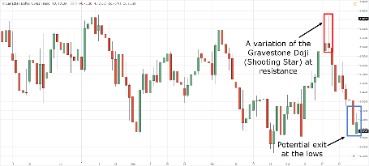Doji Candles: Popular Doji Candlestick Patterns

In this article, we will look at the Doji, which is an important type of patterns. Again, you can go short on the next candle open, stop loss either above the high and then look to ride the move down lower. So, in this case, the market came types of doji candlestick up higher into the area of resistance which is simply the highs of the Long-legged Doji. And you can use the level and the areas on your chart to establish a bias. When you see this chart, it can difficult to just trade off it directly.
The evening doji star is a three-candle bearish reversal pattern that contains a doji. This star doji has a long white candle, followed by a gap up doji, followed by a gap down bearish candle. The doji is said to be a star doji as there’s a gap on both sides, and it’s an evening because it portends darkness or bearish price action. The appearance of the doji candlestick in conjunction with the previous mentioned methods signalled that it was time to enter a short position. A doji is not as significant if the market is not clearly trending, as non-trending markets are inherently indicative of indecision. Each candlestick, including a doji candlestick, is akin to one piece of a puzzle.
What is the Difference between a Doji and a Spinning Top?
First, you determine the time frame and support/resistance levels. Below, you can see the support and resistance levels in the H4 timeframe; I also marked the local high. When a new trading period begins, the price rises sharply, then decreases. By the end of the period, the price returns to the starting mark or the level close to it. Buyers and sellers got a little more excited back and forth during the session. Generally, it represents the indecision in trading action for both sellers and buyers.
- Therefore, when trading this pattern, it is necessary to confirm the signal using other candlestick patterns or technical indicators.
- There are several practical limitations that limit how much time traders can…
- By considering the context and using the pattern alongside other indicators, traders can make more informed decisions in the ever-changing financial market.
- A Doji candlestick is one where the opening price of an asset is usually the same as the close.
- The Dragonfly Doji is often found at the bottom of a downtrend, and its appearance can signal a potential trend reversal.
Hammer doji candlesticks are created when the price opens, falls, then closes near the opening price. The Doji candlestick pattern is a technical indicator used by analysts to gauge the future price movement of securities. The pattern generally forms when the market opens with bullish trends that drive the price up. There is counterpressure from the bears who bring the price down by rejecting the higher price.
Trade your strategy
Dojis are good for reversals because they present indecision, uncertainty, or vacillation by buyers in an uptrend and sellers in a downtrend. We can easily realize this by looking at the length of the candle shadow. The size of the doji’s tail or wick coupled with the size of the confirmation candle can sometimes mean the entry point for a trade is a long way from the stop-loss location.
How you trade a doji depends on the signal your pattern is generating. The most common signal from a doji is a possible impending reversal – after all, they offer a sign of indecision, which tends to precede a change in direction. Here, buyers stepped in to try and take control early in the session – but were swiftly beaten back by sellers. If that price action continues, then the bear run will carry on, making it a continuation pattern. Here, a long green candlestick appears on an uptrend, but the bull run pauses with a doji. Then, it reverses with a long red stick which kicks off a new downtrend.
A gravestone doji candle is a pattern that technical stock traders use as a signal that a stock price may soon undergo a bearish reversal. This pattern forms when the open, low, and closing prices of an asset are close to each other and have a long upper shadow. The shadow in a candlestick chart is the thin part showing the price action for the day as it differs from high to low prices. Doji candlestick patterns are single candlesticks that have nearly identical opening and closing prices. These candlesticks may indicate a bullish or bearish trend reversal.
Understanding the Doji Candlestick Pattern
The dragonfly doji is a candlestick pattern stock that traders analyze as a signal that a potential reversal in a security’s price is about to occur. Depending on past price action, this reversal could be to the downside or the upside. The dragonfly doji forms when the stock’s open, close, and high prices are equal.
TradingView’s user-friendly interface and interactive charts make it an excellent choice for both beginners and experienced traders. This type of candlestick is confirmed on a technical analysis chart when the opening and closing prices are almost identical. Like the rest of the chartism, these Japanese candlestick patterns are approximate. It will be more useful for you to study good technical indicators over several time frames. It is, in fact, more interesting to see the behavior of prices and indicators in the candle. And do not limit yourself to a candlestick representation but always use other indicators to determine the market trends with higher precision.
Before we dive into the doji, it’s important to understand how candlestick patterns work. Candlestick charts were originally developed in Japan in the 17th century, but are now common across all countries and all markets. Every candlestick pattern has four sets of data that help to define its shape. Based on this shape, analysts are able to make assumptions about price behavior.
What Is a Doji Candle Pattern, and What Does It Tell You?
While the Doji candlestick chart pattern alone is not enough to confirm a trend reversal, it can serve as part of a broader technical setup. For example, if the Doji forms after an extended downtrend, it could signal that bears are losing control and that a reversal to the upside is likely. Likewise, if the Doji forms after an extended uptrend, it could signal that bulls are running out of steam and that a reversal to the downside is possible. As such, traders should always be on the lookout for Doji patterns when analyzing price charts. Because there are many different types of doji out there, along with spinning tops and other similar Japanese candlestick patterns, many questions often remain. We’ve designed this FAQ to address the most commonly asked questions about doji candlesticks.

A Doji is an important pattern because it can provide valuable insights into market sentiment. If the trading volume on the candle is large, it means that a maximum of buyers have intervened. As we mentioned above, Doji means the same thing in Japanese, which refers to the rarity of occurrence of open and closed prices on the market. If the two prices are not the same within a few ticks, this can be said to be a Doji.
This pattern can appear in any timeframe, but it is most commonly present on daily charts. Some common doji candlestick chart patterns include the dragonfly doji, gravestone doji, long-legged doji, star doji, and hammer doji. Each has a slightly different shape, which we discuss in more detail below. The Dragonfly doji has a T-like shape and looks like a dragonfly, that is why it is called so. Typically, a bullish doji appears in a downtrend and signals a reversal, but it can also occur in an uptrend.
Because its appearance means a potential change in market momentum, it is one of the most important Japanese candlestick patterns for a technical analyst to pay attention to. A Long-Legged Doji is a Doji that has a long upper shadow and a long lower shadow and appears at the end of an extended downtrend. A bullish or bearish trend will appear to have ended, but what is important about this pattern is that it suggests that sellers and buyers are almost equally matched. For example, “was there a preceding rally or dump?” and “was it over extended?”. Such pieces of information are only derived from analyzing a set of candlesticks together – Analyzing a Candlestick Pattern for bullish or bearish signals. Usually, doji’s make for good reversal indicators when found on overextended rallies, or oversold dumps.
What is Doji Candlestick Pattern – Working, Types, Indication and Strategy
Nothing in this material is (or should be considered to be) financial, investment, legal, tax or other advice and no reliance should be placed on it. It doesn’t require a trend and can open and close anywhere in the daily price range. It also sounds very similar to the previously mentioned spinning top.
Nifty forms long-legged Doji candle on Budget day. What traders should do on Thursday expiry – Economic Times
Nifty forms long-legged Doji candle on Budget day. What traders should do on Thursday expiry.
Posted: Wed, 01 Feb 2023 08:00:00 GMT [source]
It marks a possible reversal in the market in either an upward or downward direction and opens up a potential trading opportunity. A doji candlestick pattern works the best when trading in timeframes of one hour and longer. Dojis appear too often in shorter timeframes, and one can’t take them as serious signals for a particular price movement.
